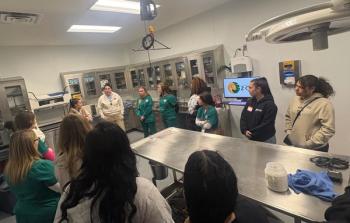
Case 11
Rintu has been receiving the infusion for two-and-a-half hours, his tremors have stopped, and his temperature is 101 F (38.3 C). You discontinue the ILE therapy at this time and place a peripheral catheter in another leg to continue crystalloid fluid therapy in order to maintain hydration and aid in toxin elimination.
If the clinical signs appear again, the dose of ILE can be repeated, but it is important to evaluate a peripheral blood sample for lipemia. If the sample is still lipemic, then it is unlikely that another dose of lipid will be of benefit.
Outcome
Rintu continues to do well and is discharged the next day. He is fully ambulatory, eating well, and no longer demonstrating any neurologic signs. In most cases of pyrethrin or permethrin toxicosis, patients may be hospitalized for two or three days depending on the severity of their signs. Use of ILE therapy in this case allowed rapid clearance of the toxin, and the patient was discharged within 36 hours.
At the time of discharge, you reiterate to Rintu's owners the importance of using all medications, including even topical products, according to the instructions in order to avoid toxicity issues. You are also sure to warn them about keeping Max and Rintu separated when applying topical flea products to Max until the product is completely dissolved or dry on Max's coat. If Rintu licks or ingests the product applied to Max, we could see toxicity issues again. As for Rintu's flea treatment, you recommend waiting another week before using any cat-specific flea control product.
Editor's note: While this interactive case is based on a patient that Dr. Garcia treated, it is a fictitious case example. As stated in the Fernandez et al. 2011 review in the Journal of Veterinary Emergency and Critical Care (citation #6) below, "If an effective therapy or antidote is already well established in the field of veterinary toxicology, the continued use of traditional therapy is recommended (eg, pyrethrin toxicosis in cats) over ILE due to the unknown effects of ILE administration in the face of other drug therapy (eg, antidote administration). If, however, the patient has undergone cardiovascular collapse secondary to local anesthetic toxicosis or any other lipophilic drug, or demonstrates significant clinical signs of toxicosis (eg, baclofen, ivermectin, moxidectin), the use of ILE should be strongly considered."
Suggested reading
1. Boland LA, Angles JM. Feline permethrin toxicity: retrospective study of 42 cases. J Feline Med Surg 2010;12(2):61-71.
2. Weinberg G. Lipid rescue resuscitation from local anesthetic cardiac toxicity. Toxicol Rev 2006;25(3):139-145.
3. Kang JH, Yang MP. Effects of a short-term infusion with soybean oil-based lipid emulsion on phagocytic responses of canine peripheral blood polymorphonuclear neutrophilic leukocytes. J Vet Intern Med 2008;22(5):1166-1173.
4. Crandell DE, Weinberg GL. Moxidectin toxicosis in a puppy treated with intravenous lipids. J Vet Emerg Crit Care 2009;19(2):181-186.
5. Clarke DL, Lee JA, Murphy LA, et al. Use of intravenous lipid emulsion to treat ivermectin toxicosis in a Border Collie. J Am Vet Med Assoc 2011;239(10):1328-1333.
6. Fernandez AL, Lee JA, Rahilly L, et al. The use of intravenous lipid emulsion as an antidote in veterinary toxicology. J Vet Emerg Crit Care 2011; 21(4):309-320.
Newsletter
From exam room tips to practice management insights, get trusted veterinary news delivered straight to your inbox—subscribe to dvm360.






